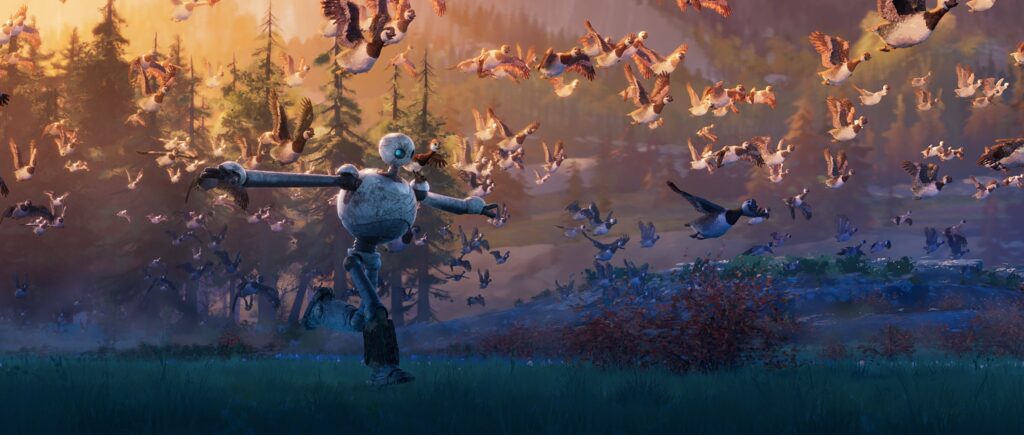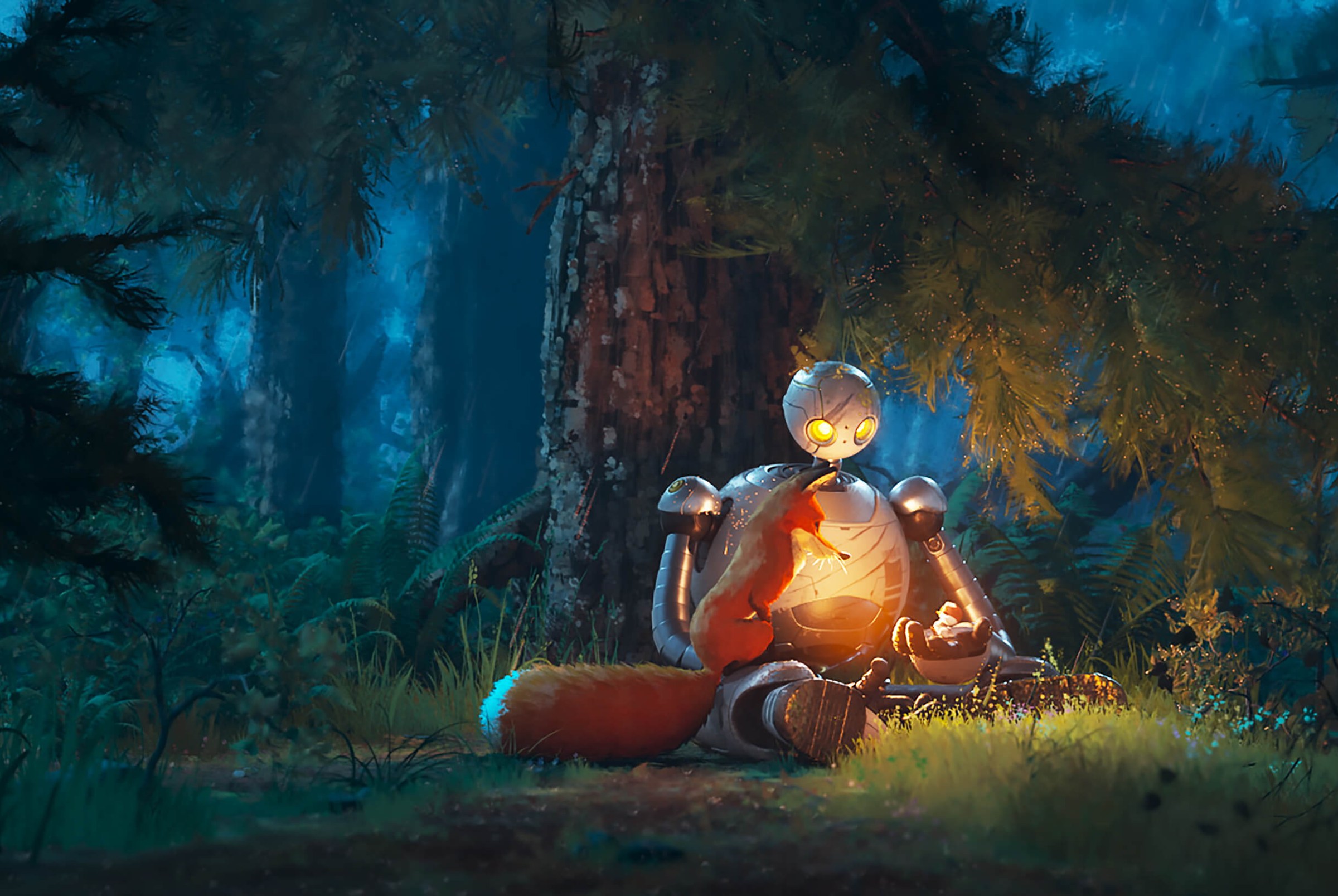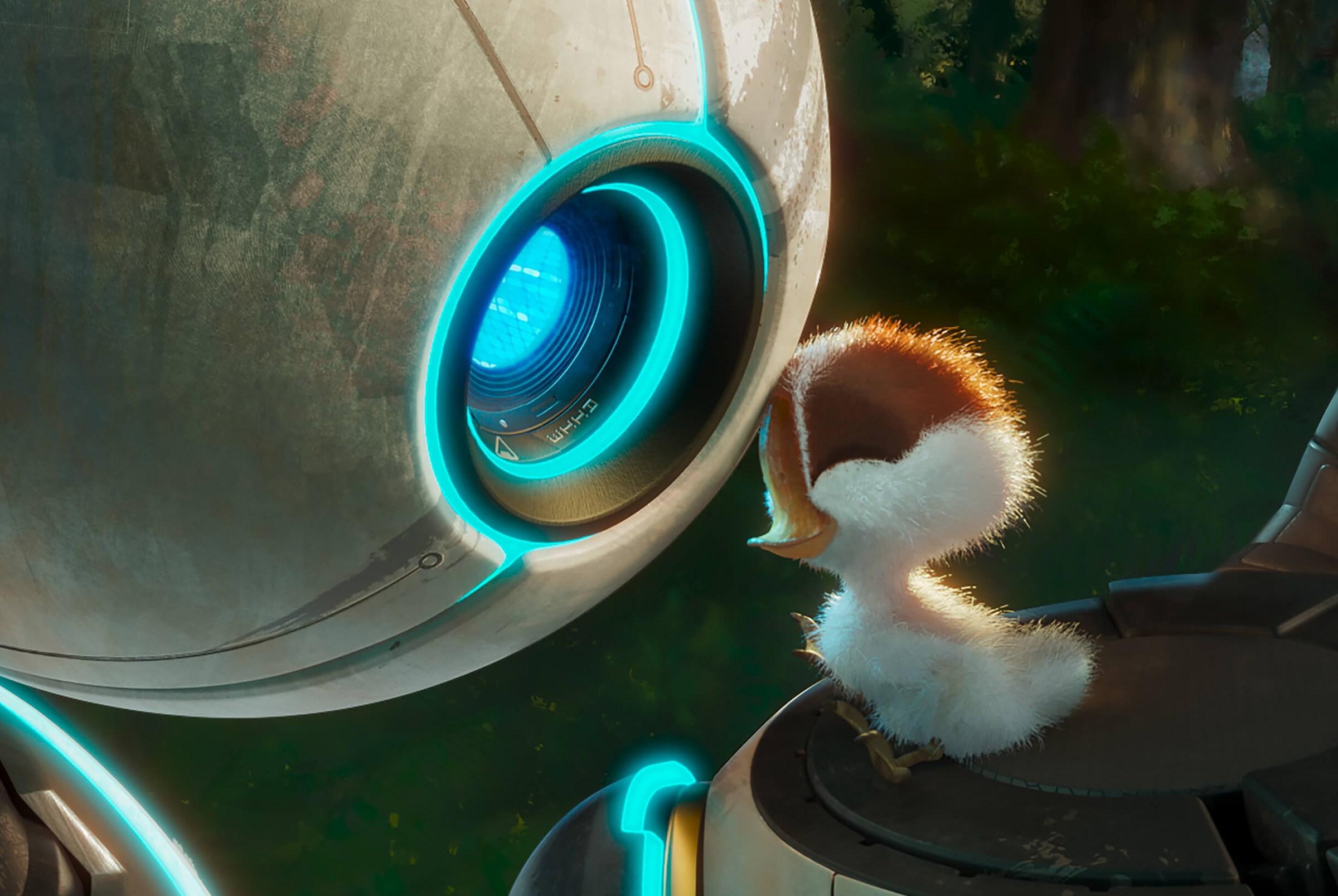In late 2022, Puss in Boots: The Last Wish came as a complete surprise. Instead of a tired Shrek spinoff using the same overdone style of the previous five Shrek-related movies, DreamWorks delivered a gorgeously animated and poignant story that harkened back to the actual meaningful themes of the original Shrek, before the franchise became one big pop culture spoof.
The Wild Robot, DreamWorks’ latest movie, proves that the departure in The Last Wish wasn’t a fluke, but the beginning of a new era. From director Chris Sanders (Lilo & Stitch, How to Train Your Dragon), The Wild Robot is a tenderly crafted story that pushes computer animation in a beautiful new direction — and is exactly the sort of movie that the current animation landscape so desperately needs.
[Ed. note: This review contains minor spoilers for The Wild Robot.]
Based on the middle-grade book by Peter Brown, The Wild Robot follows a robot named Roz (Lupita Nyong’o) who finds herself stranded on a remote island. Roz’s directive is to assist people in everyday tasks, but the wild, human-less environment offers little for her programming. After a while, she eventually figures out how to communicate with the wildlife, who react in overwhelmingly hostile ways until she accidentally adopts a newly hatched gosling, who imprints on her. Roz declares her new directive: help the runty gosling grow up and be ready for his first migration in the fall. With the help of a fast-talking fox named Fink (Pedro Pascal) — who sees the big robot as a ticket to safety — Roz raises the little gosling, who she names Brightbill (Kit Connor). But the trio are an odd match in the forest, and they struggle to fit in with the rest of the woodland community. The friction that threatens Brightbill’s chances for survival.
The Wild Robot takes place roughly over the course of a year on the forest island (which seems to be located nebulously in the Pacific Northwest), and through all the seasons and weather. The visuals are immensely captivating, and the setting is so vibrant and lush. All of the animation is painterly and stylized, in a manner similar Puss in Boots: The Last Wish, but taken in its own direction. Concept art for animated movies often is more stylized, especially in texture and coloring, than the final products, which for years have chased a photorealistic look, but The Wild Robot closes that gap, looking just as rich as a painting. The trees aren’t rendered in microscopic detail, and the water isn’t supposed to look like hyper realistic water; instead, Sanders captures the feeling of this wild landscape, both in its beauty and its hardship — swaths of autumnal color, a violent thunderstorm that shakes the island to its core, a bitter snowstorm that chills all the creatures, and more.
Beautiful animation is one thing, but The Wild Robot is built on a damn good story. Robots going against their programming and unlikely parent-child-esque relationships are common tropes, but Sanders isn’t afraid to drill down to the emotional core, even if that means not flinching away from sadder moments. His script homes in on Roz and Brightbill’s connection, threading in moments like Roz letting the little gosling help build shelter, even though the tiny branches he carries don’t really assist her current directive, or Brightbill curling up right under Roz’s neck joint when she powers down and he falls asleep. But it also pulls back to show how their blossoming dynamic impacts the rest of the forest. For a story that’s so intrinsically tied to its environment, that’s a necessity.
The film’s emotional power is particularly evocative because Roz’s design has no facial articulation. It’s all conveyed through her overall body language and the lights that flicker on her “eyes.” Nyong’o’s voice performance anchors Roz’s character. Many of the formative moments in Roz and Brightbill’s relationship come before Brightbill can talk too, so it’s all fueled through their body language, character designs, and Nyong’o’s acting — a testament to the strength of the cartooning.
Roz and Brightbil’s mother-son relationship certainly drives a lot of the movie, especially since it challenges Roz’s prior programming. But it’s one part of the greater ecosystem, and the story ripples through the rest of the forest critters, which in turn comes back to the ebbs and flows of their special connection. There’s only so much Roz can teach Brightbill about swimming, when she’s a robot made by humans and drawing from human-centered databases; this puts him at odds with his fellow geese, and in turn, he lashes out at Roz. It’s all woven tightly together, with enough space given for each emotional beat, be they wondrous, comedic, or bittersweet.
Even though it’s a movie full of talking animals, The Wild Robot never feels cheap or full of gags – but it’s genuinely funny. Catherine O’Hara’s weary possum mom provides a lot of laughs, as does a single-minded beaver voiced by What We Do in the Shadows’ Matt Berry. The giggles strengthen the heart of the movie, which is about the complications of parenthood, the importance of kindness, and the unlikely bonds we forge with others that reveal hidden sides of ourselves.
DreamWorks released two theatrical movies in 2024, and they both indicate two paths forward not just for DreamWorks, but for American animation. One was the entirely fine Kung Fu Panda 4, a sequel that basically set up more sequels and didn’t really do anything new. And the other is a masterpiece. The Wild Robot is exactly the type of movie that the American animation landscape — so full of sequels and disappointing nostalgia-fests — needs. It’s fresh and not tied to an existing billion-dollar IP. It’s a good story that tackles big themes, but never in a way that seems too lofty for children or too pandering for adults. And it looks amazing, another step forward in the new direction that Spider-Man: Into the Spider-Verse spearheaded in 2018. DreamWorks has two roads in front of it, and it’s clear which path the studio should take.
The Wild Robot is out in theaters now.



